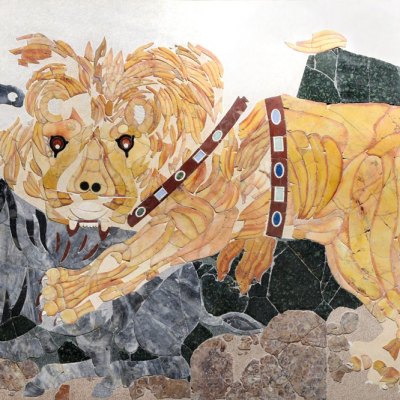The first time Dorothy Cross saw the little block of red marble she was immediately drawn to it. When they told her this type of marble is called Damascus Rose, there was no stopping her. ‘That’s what set the ball rolling for the entire show,’ she tells me via Zoom from her home in Connemara on Galway’s Atlantic Coast. ‘That collision between this appearance like flesh and the name “Damascus Rose”, with the contemporary situation in Syria, that hit me first, because it’s such an abomination what’s happening there.’ It was just before the first lockdown, back in 2020, in the stonemason’s yard at Studio Carlo Nicoli in Carrara, some 60km north-west of Florence. The slab looked like a hunk of well-marbled meat with its veinous surface and gory pink hues. It became, for Cross, an image of all the blood that has been spilled in and around the Syrian capital since the start of the civil war a decade ago – as well as the many Damascene lives lost trying to escape to Europe.
Red Baby (2021), Dorothy Cross. Photo: Stephen White & Co. Courtesy the artist and Frith Street Gallery, London; © Dorothy Cross

The plight of refugees has been a concern of Cross’s work for some time now. Already in 2019, her work Heartship for the Sounds from a Safe Harbour festival in Cork paid tribute to the Irish Naval Service vessels that saved hundreds of lives on search-and-rescue missions in the Mediterranean since 2017. The singer Lisa Hannigan performed solo on the top deck, wrapped in a silver emergency blanket, her voice drifting across the harbour to an audience gathered on the dock. Inside the boat, on one of the lower decks, sat a real human heart encased in lead. ‘Nobody saw the heart,’ Cross admits. That didn’t deter her. ‘I had to borrow a human heart to put on the ship. Had to. I had this idea.’ This was no mean feat. There are certain rules about doing things with real human organs. It took four years. Eventually, they managed to rent one from the Pitt Rivers Museum. But its presence there, unseen, deep in the body of the ship, was crucial to Cross somehow. ‘It added richness to the whole thing,’ she says, ‘and truth. I’m very interested in coming as close as we can get to a truth.’
Cross was born in Cork. A swimming champ in her teens, her ‘escape’, she says, ‘was drawing’. At 18, she moved to England, thinking ‘art didn’t exist in Ireland’. She ended up at Leicester Polytechnic studying three-dimensional design, arriving in the area just in time for the Birmingham pub bombings of 1974. ‘It was ghastly,’ she recalls. After winning a design competition, she flew with no-frills pioneer Laker Airways to San Francisco and enrolled at the Art Institute for an MFA in printmaking. ‘It was after its real heyday,’ she says of the one-time alma mater to Michael Heizer, Annie Leibowitz and Paul McCarthy, but she remembers ‘stunning’ visiting artists, such as John Cage. It was at San Francisco Art Institute, she tells me, that Cross ‘learned how to speak about art’.
‘When I said, the work speaks for itself to this guy, he said, no it doesn’t, honey. I was forced to consider the significance of every single thing I did.’ But while this helped to clarify her thoughts about her burgeoning practice, she felt alienated from the ‘academic language’ of the art school. ‘I think it’s stultifying and crippling and really ridiculous a lot of the time,’ she tells me. ‘It’s for a certain scene of people who enjoy that. It’s not for me and it’s certainly generally not for the audience.’ Meanwhile, San Francisco’s proximity to the great deserts of Nevada, Arizona and eastern California made it a perfect base of operations for day trips into the American interior, discovering a love for geology that, she tells me, is ‘coming back now into the type of material I’m using’.
Blue Dive (2021; detail), Dorothy Cross. Photo: Stephen White; courtesy the artist and Frith Street Gallery, London

In the 1990s, while Damien Hirst was exhibiting sharks and sheep in formaldehyde tanks and Mark Dion crafted intricate dioramas of taxidermied creatures, Cross found recognition via a series of sculptures, such as Saddle and Spurs and Virgin Shroud (all 1993), made wholly or partly out of real cow udders. ‘I couldn’t do that now,’ says Cross, now a vegetarian. ‘I would cry. Even back then when those cows arrived there was a sadness. I was really manipulating the outside of these beautiful animals. There was something really grotesque but also tender about it.’ But her growing engagement with marble in recent works such as Blue Dive (2021) in which a perfectly carved pair of feet emerge from a hunk of cool blue Brazilian sodalite, or Red Baby (2021), an ear emerging from a cushion of Damascus Rose, sees a move from sculptures made of flesh towards representations of flesh made out of more traditional sculptural material. ‘The essence of it is the same thing,’ she maintains. ‘Because we are all carbon in the end.’
For an artist whose work has often dealt with decay and disappearance – a whole book called Gone by Robin Lydenberg is dedicated to the ‘the ephemeral quality of Cross’s work’ – marble also makes for a decidedly more permanent material. ‘But that’s not what it’s about,’ she insists – and here she taps the table in front of her with her forefingers for emphasis, ‘It’s about the now.’
‘Dorothy Cross: Damascus Rose’ is at Frith Street Gallery Golden Square until 14 April 2022.



